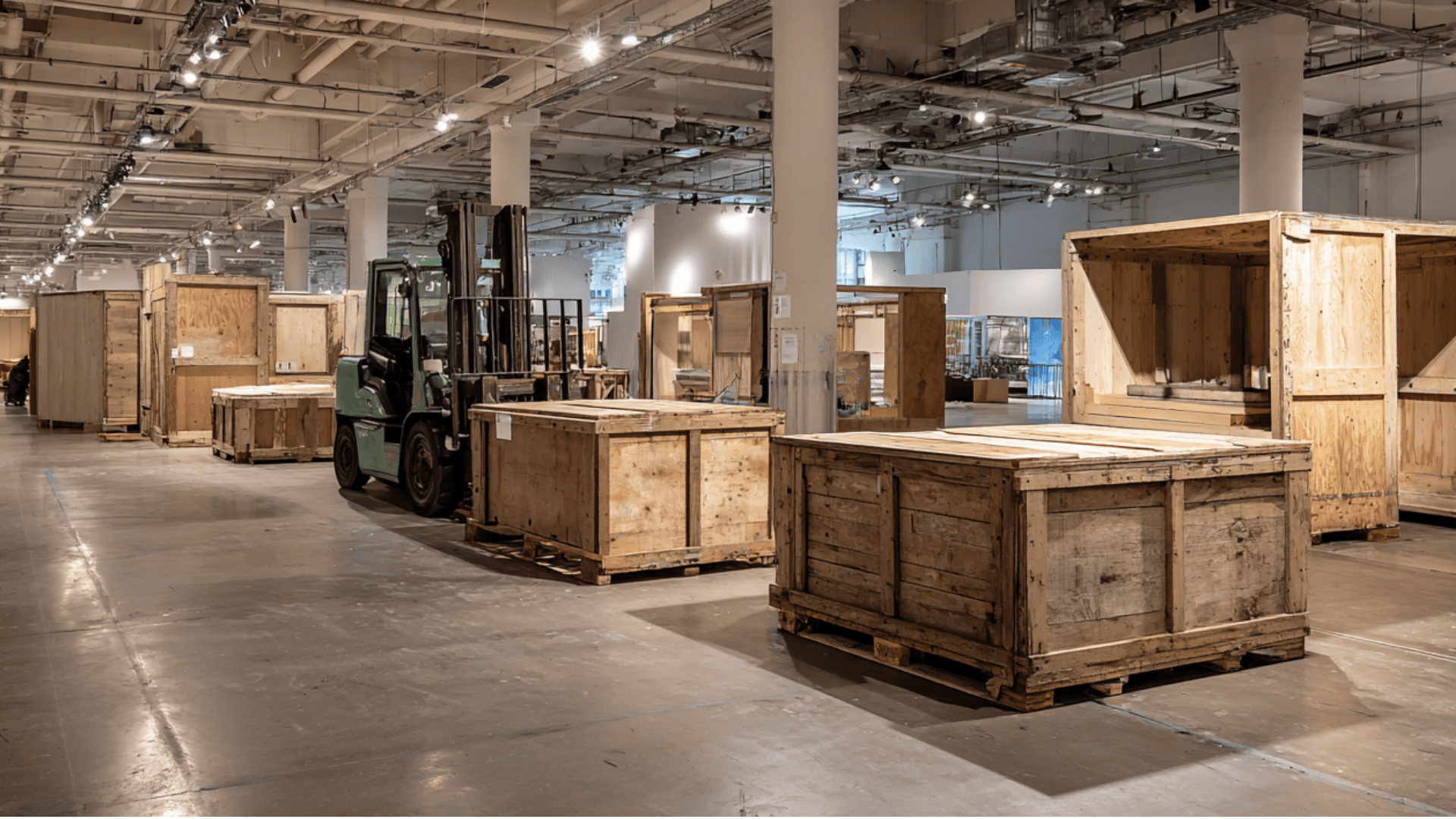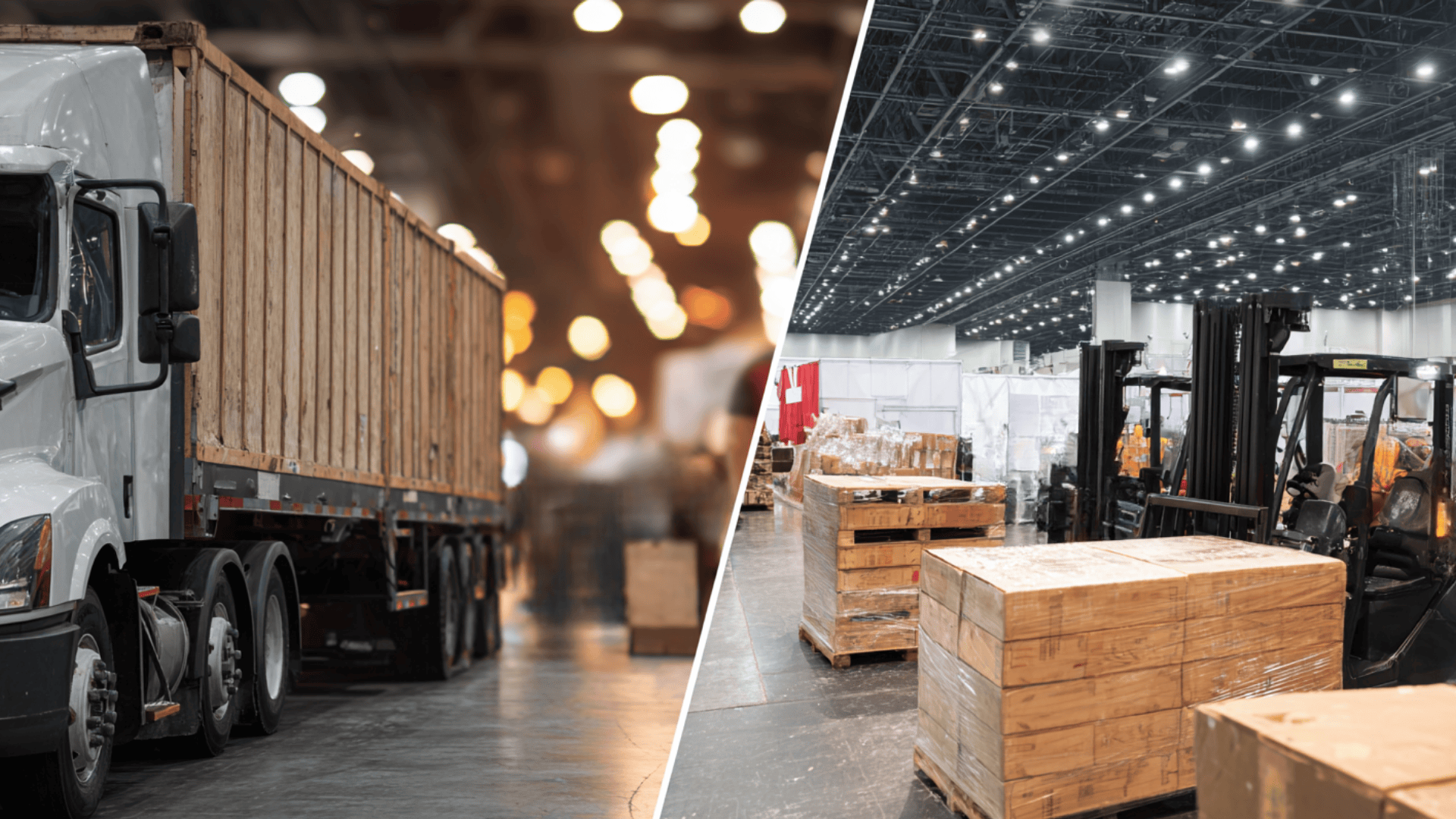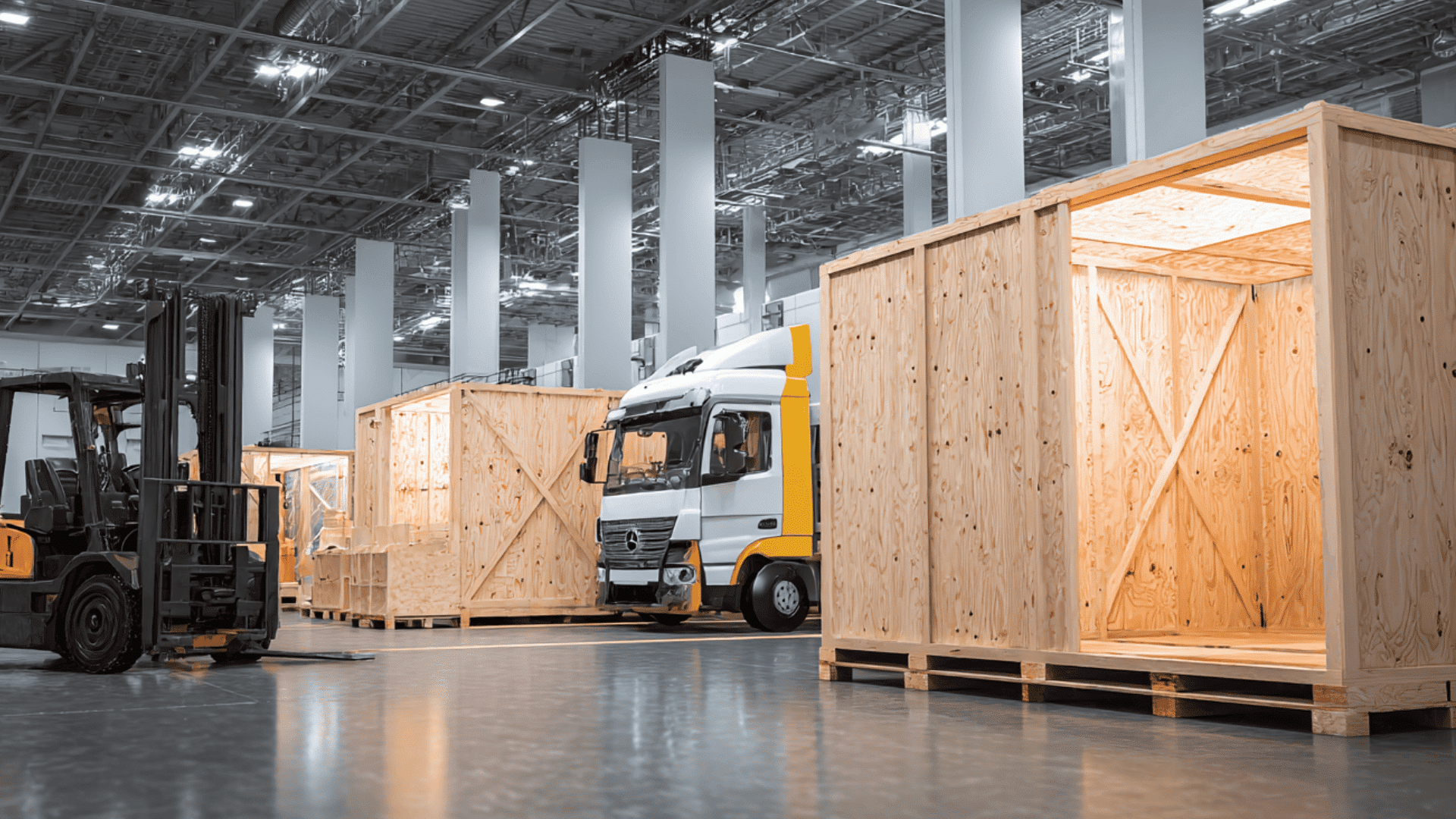Getting your booth, displays, and equipment to a trade show isn’t as simple as booking a truck. I’ve learned that trade show shipping has its own rules, deadlines, and hidden costs that can catch you off guard if you’re not prepared.
In this guide, I’ll walk you through what trade show shipping really means, how it’s different from regular freight, and the steps you can take to plan it right.
By the end, you’ll know how to budget smartly, avoid costly mistakes, and choose a shipping partner you can trust.
What is Trade Show Shipping and Why It’s Different

Trade show shipping refers to the process of transporting booths, displays, marketing materials, and equipment to and from an exhibition. At first glance, it may sound like regular freight shipping, but in reality, the requirements are far more complex.
How It Differs from Regular Freight
Trade show shipping is more complex than standard freight. Deliveries must meet strict move-in and move-out windows, with penalties for missed deadlines. Booth materials are often fragile or oversized, such as panels, lighting, and electronics, requiring extra care.
Unlike regular freight, shipments undergo multiple stages, including warehouses, marshaling yards, and drayage teams, before reaching the booth, making timing and coordination critical.
Key Logistics Terms Exhibitors Must Know
- Advance Warehousing: Ship to a warehouse weeks early; adds storage fees but ensures readiness.
- Direct-to-Show: Deliver straight to the venue during move-in; cheaper but deadline-sensitive.
- Marshaling Yard: Truck holding area; delays here increase costs.
- Drayage: Moving freight from the dock/warehouse to the booth; often the biggest expense.
- Timelines: Strict delivery, setup, and teardown schedules; missed windows mean penalties.
Why Specialized Planning and Services Are Necessary
Due to these complexities, specialized trade show shipping providers exist to manage the details that exhibitors often overlook. They understand the flow of a show, coordinate directly with event organizers, and handle paperwork and scheduling on your behalf.
Without proper planning and experienced partners, exhibitors risk late arrivals, damaged materials, unexpected charges, and lost opportunities to connect with attendees.
The Trade Show Shipping Process Explained
Shipping materials to a trade show involves more than just booking a carrier; it also requires careful planning and coordination. Understanding each step of the process helps you plan more effectively.
1. Advance Warehousing
Advance warehousing means sending your booth and materials to a designated storage facility weeks in advance of the show.
Benefits:
- Your materials are staged and ready at the venue before move-in begins.
- It reduces the risk of last-minute delays from weather or shipping issues.
- You avoid the chaos of direct-to-show deliveries.
Timelines: Shipments typically need to arrive two to four weeks prior to the show’s opening.
Costs: Advance warehouse handling fees are higher than direct-to-show shipping, but the reliability often outweighs the extra expense.
2. Direct-to-Show Site Shipping
Direct-to-show shipping sends your freight straight to the convention center during official move-in times.
Risks:
- Delivery windows are tight-sometimes only a few hours.
- If your truck arrives too early or too late, you may face costly delays.
- Missed deliveries can mean your booth isn’t set up in time for the event.
When to Use: Direct-to-show can work if you’re local, have light shipments, or want to save on warehouse fees. But it’s riskier for large or complex booths.
3. Drayage and Material Handling
Drayage, also known as material handling, is one of the most confusing aspects of trade show shipping. It refers to the service of moving freight from the warehouse or loading dock to your booth space.
How It’s Charged:
- Typically billed by weight, often per 100 pounds.
- Rates vary by show and venue, and surcharges apply for overtime or off-hours delivery.
Why It Surprises Exhibitors: Many first-time exhibitors are unaware that drayage is a separate cost from shipping, which can add thousands of dollars to their budget.
4. Packaging and Labeling Best Practices
Use sturdy, reusable crates or heavy-duty cases instead of cardboard. Clearly label each piece with your company name, booth number, show name, and contact details.
Protect fragile displays with foam or padding, and secure items to prevent shifting during transport.
Challenges and Troubleshooting in Trade Show Shipping
Shipping to a trade show presents unique challenges, and even minor oversights can lead to significant problems. Late bookings often drive up costs, unclear labeling causes delays, and skipping insurance leaves materials vulnerable to damage.
Hidden costs, such as drayage, storage, and surcharges, also often surprise many exhibitors.
How to Avoid These Pitfalls:
- Plan and book early: Secure better rates and reliable carrier options.
- Insure all freight: Protect shipments from damage or loss.
- Use sturdy crates: Opt for reusable cases over cardboard for safer transportation.
- Label clearly: Include company name, booth number, show name, and contact details.
- Stay organized: Keep paperwork handy to avoid delays.
- Track shipments: Utilize real-time tracking for enhanced visibility and expedited problem-solving.
By addressing common mistakes and following these steps, exhibitors can reduce risk and keep their shipping process on track.
Choosing the Right Trade Show Shipping Provider

Choosing the wrong provider could mean damaged freight, unexpected costs, or even missed show days. To evaluate potential partners, consider their comprehensive scope of services, not just their price. Below is a quick breakdown of what to consider:
- Experience and Reputation: Select providers with proven trade show experience, ideally in your specific industry and at the same venue.
- Transparent Pricing: Ensure quotes list all charges, including drayage, overtime, and surcharges.
- Technology and Tracking: Look for real-time tracking tools to monitor freight from the warehouse to the booth.
- Problem-Solving: Ask about contingency plans for delays, damage, or lost items.
- Customer Proof: Check reviews, case studies, and testimonials for reliability.
- Additional Services: Consider providers offering storage, booth setup, or dismantling support.
The right provider doesn’t just move freight-they become a logistics partner who helps you plan, anticipate problems, and stay focused on making the most of your trade show presence.
Cost and Budget Considerations
Trade show shipping costs vary depending on booth size, distance, and the type of service. Most carriers bill per 100 pounds (CWT), so heavier booths naturally incur higher costs.
Distance also plays a role, as longer hauls increase freight and fuel costs. Additionally, services such as advanced warehousing, expedited delivery, or special handling contribute to the total.
In addition to base freight, exhibitors should prepare for hidden costs that often come as a surprise:
- Drayage fees for moving freight inside the venue.
- Surcharges for overtime, weekends, or late deliveries.
- Storage fees if shipments arrive too early.
- Return shipping to move materials back after the show.
The best way to stay on budget is through careful planning and budgeting. Obtain quotes from multiple providers and request itemized estimates to identify any hidden charges.
Ensure your budget includes drayage, storage, and return shipping, and always set aside a 10–15% contingency fund for unforeseen issues.
By accounting for these factors upfront, you’ll reduce last-minute stress and keep your shipping plan cost-effective.
Tools and Calculators for Estimating Costs
Many trade show shipping providers offer online calculators that estimate costs based on shipment details such as weight, dimensions, pickup and delivery locations, and show dates.
These tools generate a breakdown that may include freight charges, drayage, storage fees, and return shipping. They also allow you to compare options, such as advanced warehousing versus direct-to-show delivery.
Some helpful tools include:
MODdisplays Event & Trade Show Cost Calculator – Helps budget for booth space, design, shipping, and other event costs.
Vivid Exhibits Budgeting Calculator – An interactive tool that estimates expenses like shipping, booth rental, and ROI tracking.
CalculatorsHub Trade Show Cost Calculator – A simple calculator that aggregates booth setup, marketing, travel, and shipping expenses.
Using these tools early in your planning stage helps you avoid surprises, compare providers, and negotiate more confidently.
Transactional Guide: How to Take the Next Step
Once you understand how trade show shipping works and what it costs, the next step is to put your plan into action.
1. How to Request a Trade Show Shipping Quote
Most specialized providers allow you to request a quote online. Start by reaching out to at least two or three companies so you can compare services and pricing.
Be sure to ask for an itemized estimate so you understand what’s included and what might incur additional costs (such as drayage or overtime fees).
2. What Information You’ll Need to Provide
Shipping quotes are only as accurate as the details you give. Have the following ready before reaching out to a provider:
- Shipment dimensions and total weight
- Number of crates, pallets, or cases
- Event name, venue, and booth number
- Move-in and move-out dates or assigned time windows
- Special handling needs (fragile items, electronics, climate-sensitive materials)
3. Booking Services: Timelines and What to Confirm
After reviewing quotes, confirm your booking well in advance- ideally, three to four weeks prior to the show. When finalizing, double-check:
- Delivery deadlines and time windows
- Advance warehouse vs. direct-to-show instructions
- Return shipping details (so your materials aren’t stranded after the show)
- Tracking and customer support availability during transit
4. Steps to Follow
- Confirm Event Details – Verify show dates, booth number, and venue restrictions like labor rules or weight limits.
- Prepare Your Shipment – Make an inventory, label crates clearly, and pack fragile items securely. Decide on advance warehousing or direct-to-show.
- Handle Paperwork – Complete the Bill of Lading, attach labels, and share schedules with your team and carrier.
- Track and Ship Out – Monitor tracking updates, check delivery on-site, inspect for damage, and keep records for return shipping.
With these steps in place, your trade show shipping process becomes more predictable, giving you the freedom to focus on what matters most: making an impact on the show floor.
Full-Service vs. Basic Carriers: Choosing the Right Fit

Choosing between a basic freight carrier and a full-service trade show shipping provider depends on the size, complexity, and value of your shipment. Here’s a quick look to help you decide:
| Feature | Basic Freight Carrier | Full-Service Trade Show Shipping Provider |
|---|---|---|
| Best For | Small, simple shipments, such as pop-up displays or a few boxes of materials. | Larger booths, fragile displays, electronics, or international shipments. |
| Services Provided | Transport freight from the origin to the destination. | Handle end-to-end logistics, including paperwork, scheduling, and coordination. |
| Paperwork | You manage bills of lading, customs, and exhibitor forms yourself. | Provider completes and manages all necessary paperwork. |
| Coordination | Limited; the carrier delivers to the venue but doesn’t manage show logistics. | Coordinates with advance warehouses, marshaling yards, and show organizers. |
| On-Site Support | None; issues at the venue are your responsibility. | Often provide staff at the show to troubleshoot delays and ensure smooth drayage. |
| Extra Services | None beyond transportation. | May offer storage between shows, unpacking/repacking, and booth setup assistance. |
| Cost | Lower upfront costs, but you may face hidden expenses if problems arise. | Higher upfront, but often saves money and stress by preventing delays or damage. |
The right choice depends on your booth size, budget, and comfort with logistics. Basic carriers suit simple shipments, while full-service providers protect larger investments.
Conclusion
Trade show shipping can feel overwhelming, but once I broke it down, timelines, drayage, warehousing, and choosing the right provider, it started to make sense.
For me, the biggest takeaway is that planning early and selecting a partner who is familiar with the trade show world saves money, stress, and last-minute chaos.
If you’re preparing for your next event, take the time now to obtain quotes, compare services, and plan your shipping strategy. It’s one of the smartest investments you’ll make.
Ready to simplify your trade show shipping? Start by reaching out to a trusted provider today and get your plan in motion.















